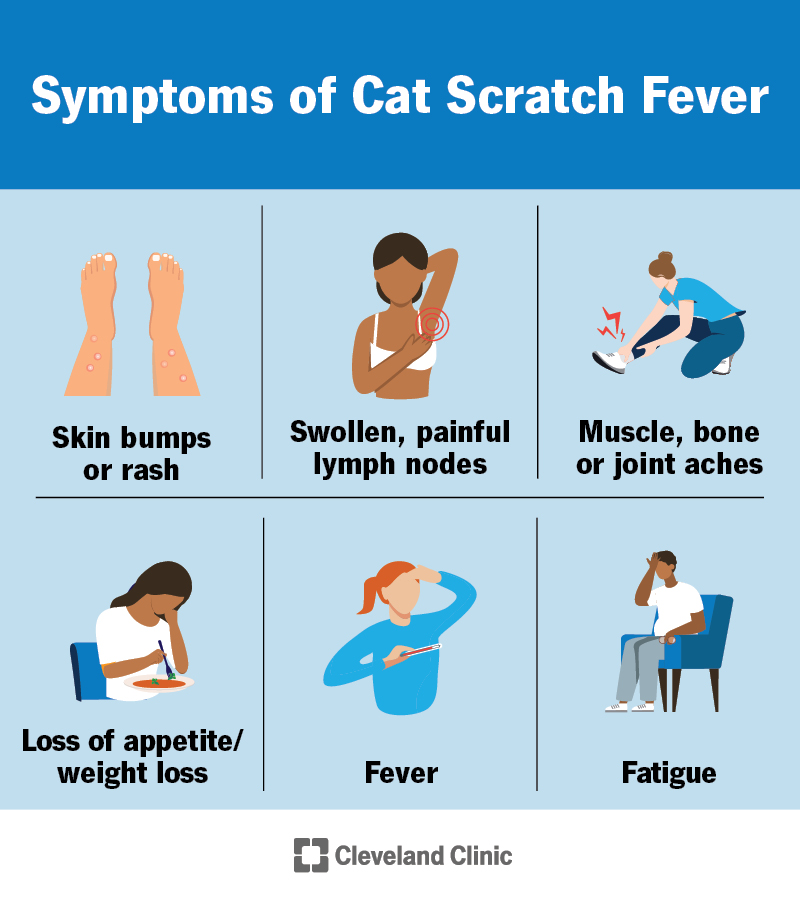Cat scratch fever (cat scratch disease) is an uncommon bacterial infection you can get from a cat scratch or bite. Cats get infected with the bacteria (B. henselae) from flea bites. Symptoms include a rash or bumps on your skin, swollen lymph nodes and fever. Cat scratch disease usually goes away on its own in a few weeks or months.
Advertisement
Cleveland Clinic is a non-profit academic medical center. Advertising on our site helps support our mission. We do not endorse non-Cleveland Clinic products or services. Policy

Cat scratch fever (usually called cat scratch disease or CSD) is an illness caused by the bacteria Bartonella henselae (B. henselae). It causes swollen lymph nodes, bumps on your skin and a fever. B. henselae can infect you if a cat bites or scratches you or licks an open wound you have.
Advertisement
Cleveland Clinic is a non-profit academic medical center. Advertising on our site helps support our mission. We do not endorse non-Cleveland Clinic products or services. Policy
Cat scratch disease has two telltale signs: swollen lymph nodes and bumps under your skin (papules). The bumps can look like a rash or more like nodules, and they’re usually near the infected wound.
Symptoms of cat scratch disease start three to 10 days after a cat scratch or wound. They include:
B. henselae bacteria cause cat scratch disease. Fleas spread B. henselae to cats. Cats (especially kittens) can have a blood infection from the bacteria without symptoms for months. Cats can then spread the bacteria to humans when they scratch or bite you, or if they lick a wound you already have.
It’s possible that getting bitten directly by a flea could give you cat scratch disease, but this hasn’t been proven.
Anyone who’s around cats is at risk for cat scratch disease. But it’s most common in kids under 15. If you have HIV or a weakened immune system, you’re at higher risk for serious complications of cat scratch disease.
CSD can become more serious if it spreads to other organs. Complications include:
Advertisement
If you have a weakened immune system, you might develop bacillary angiomatosis or bacillary peliosis. Bacillary angiomatosis causes excess blood vessels to form, creating masses or cysts on your organs and bones. You might get large, raised bumps on your skin. Depending on your skin tone, they might be darker than the surrounding skin or bright red. Bacillary peliosis causes blood-filled cysts on your liver.
To diagnose cat scratch disease, your healthcare provider will perform a physical exam. They’ll:
Sometimes, a provider diagnoses cat scratch disease just with this exam. Your provider may also take a sample of your blood to test for signs of a B. henselae infection. In rare cases, they might take a sample of fluid from one of your lymph nodes to test for infection.
Since cat scratch disease usually goes away on its own, treatment often aims to help ease your symptoms in the meantime. Your healthcare provider might prescribe an antibiotic to get rid of the bacteria. This is usually only if you have a compromised immune system, complications or long-lasting symptoms.
If you have a very large or painful lymph node, your healthcare provider might drain it.
You can manage the symptoms of cat scratch disease at home by:
Swollen lymph nodes from cat scratch disease last anywhere from two to eight weeks. They usually get better on their own.
Visit your healthcare provider if you have:
Go to the emergency room if you have symptoms of an infection that’s spread to other parts of your body, including:
Cat scratch disease is usually self-limiting — that means that it goes away on its own without causing complications or long-term effects. In a small number of people, the infection spreads to other organs, causing serious illness.
If you’re around cats, try to avoid bites or scratches and don’t let them lick wounds you have. A few other things you can do to reduce your risk of infection include:
Advertisement
Since cats get B. henselae infections from fleas, it’s less likely that you’d get CSD from an indoor cat who never goes outdoors. If your cat has had fleas or is newly adopted (especially a kitten), they could have a B. henselae infection.
Cat scratch fever is a real illness, not just a song that gets stuck in your head. Fortunately for cat lovers, there are simple ways to protect yourself and your cat from infections. If you have any symptoms of cat scratch disease, contact your healthcare provider. They can help you manage your illness and keep an eye out for complications.
Advertisement
Have a virus, fungus or bacteria? Some of these “bugs” won’t go away on their own. Cleveland Clinic’s infectious disease experts are here to help.

Last reviewed on 08/11/2025.
Learn more about the Health Library and our editorial process.